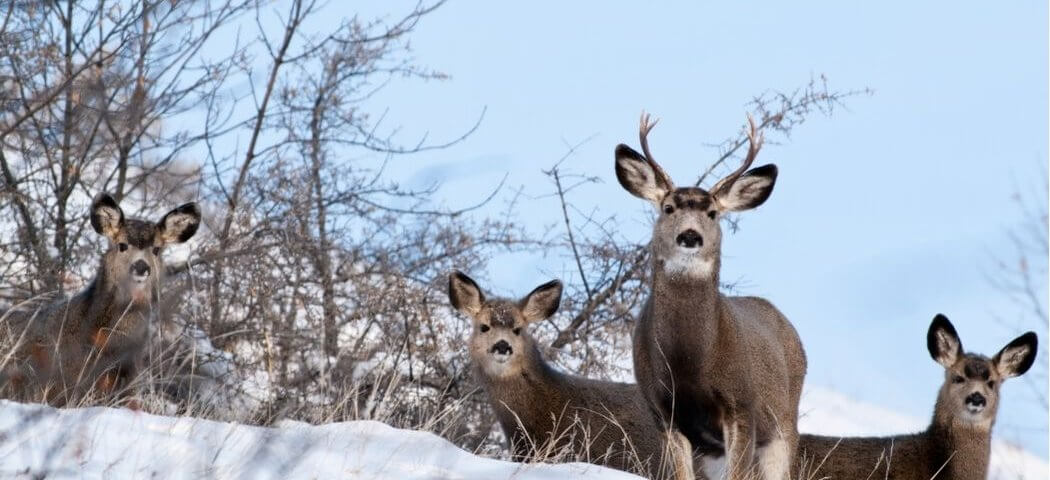Comment on WDFW’s Recreation Strategy

Setting Zoning Priorities-February 28 Deadline
February 16, 2022
Getting the Comp Plan Right
February 19, 2022Comment on WDFW’s Recreation Strategy
The wildlife habitat that borders much of our valley bottom development in the Methow is an essential part of maintaining our rural character. These Washington Department of Fish and Wildlife (WDFW) public lands give mule deer, beaver, grouse and so many other species a refuge away from more intensive human interaction. The management of these lands on behalf of wildlife (who cannot speak at the table themselves) is vitally important if we want to sustain the abundant wildlife we do have here.
Last month, we encouraged our supporters to fill out a WDFW survey to map recreation use in the Methow Wildlife Area to help the agency align use with conservation goals. This month, we are encouraging the public to provide public comments on a new statewide 10-year Recreation Strategy that WDFW is developing. WDFW manages 33 wildlife acres–1 million acres–around the state. The agency’s stated primary goal is “to provide habitat for healthy and diverse fish and wildlife populations.” A secondary goal of the agency is to “provide sustainable fish and wildlife-related commercial and recreational opportunities.” A statewide boom in recreational use of WDFW lands and waterways is prompting the agency to develop a strategy to address increasing recreational demand.
We applaud the Recreation Strategy’s effort to develop appropriate regulations and establish better enforcement of them. MVCC has concerns around the growing impact of recreation and sees the strategy as an important management tool to safeguard wildlife and their habitats. The Strategy should identify concrete and achievable steps to move us towards desirable protect and restore habitat conditions now and in the future.
Our main comments on the strategy are outlined below:
What we like:
- Acknowledges the need for a sound monitoring program to evaluate environmental impacts and support science-informed decisions for balancing conservation and recreation.
- Monitoring results will be used to establish zones where different recreation uses are most appropriate
- Complete trails and roads inventory will help address illegal and unauthorized trails and roads
- Engages Tribes and underrepresented communities in recreation planning and program development as well as working with community advocates to develop and conduct outreach.
- Will develop systems and programs in partnership with the Tribes to mitigate the impacts of outdoor recreation and protect significant cultural and natural resources.
- A series of facilitated listening sessions will explore opportunities to make WDFW-managed lands more welcoming to visitors that reflects the rich diversity of Washington State’s population.
- Reduces regulatory uncertainty and allows for area-specific policies as a result of a revised approach to rulemaking.
- In consultation with tribes and other government partners, all informal routes that can damage vegetation, displace wildlife, alter hydrology or further fragment landscapes will be closed or redesignated for public use.
- WDFW will propose a statewide rule prohibiting the cutting of standing (dead or living) trees and shrubs except with a department-issued permit.
- WDFW will develop a consistent and transparent process for area-specific rulemaking, allowing some flexibility to address site-specific protections.
Areas that need clarification or could be improved upon:
- Create clear policy that provides strong protection for wildlife and their habitats.
- Too much recreation can negatively impact wildlife and result in a loss of biodiversity. Our hope is that this strategy can remain compatible with the primary mission of WDFW–“provid[ing] habitat for healthy and diverse fish and wildlife populations.”
- This Strategy is not a prescriptive plan, but rather a framework which references and relies on other mega-strategies that have not yet been defined or are newly established pilots. Key concepts such buffers and land classifications require clarification. We look forward to learning more once the Strategy begins to assess specific measurables.
- The Strategy lacks clear planning direction pertaining to travel management, including the uses of motorized and off-highway vehicles, which are proven to disrupt habitat and displace wildlife.
- Emphasize and incorporate climate change into existing management. While the Strategy makes mention of the impacts of climate change on outdoor recreation, it should also encourage recreation that reduces impacts on the climate by prioritizing climate-aware forms of recreation.
- It is important to acknowledge that people are part of the ecosystem and their behaviors can further fragment the landscape. When managing Wildlife Areas, WDFW needs to continue to place wildlife first and foremost.
- Adapt and develop outdoor recreation and education to be climate appropriate. Prioritize infrastructure for non-motorized transportation, concentrate trails nearby central access points and provide shuttle services for recreation.
- Within the context of the larger surrounding landscape, fewer wildlife refugia remains. Many Wildlife Areas are places away from our built environment where wildlife can feed and breed.
- Ensure the Strategy is implemented into the future by securing long range funding through the state legislature.
- Sustainable funding for increased staffing and enforcement can be uncertain and will rely on bipartisan support in the state legislature.
- Consider the funding necessary to manage species that become at-risk due to an increase in recreation pressure.
- Funding backlogged projects and maintenance should be prioritized.
An online public meeting will be held on Thursday, February 24 from 10:30-noon to discuss the draft recreation strategy.
A recording of the virtual public meeting that WDFW held on February 10 to discuss the draft strategy which can be listened to here.


